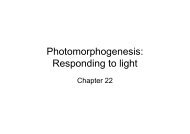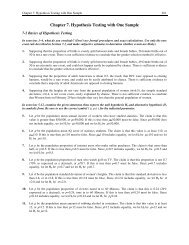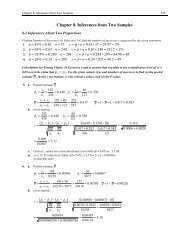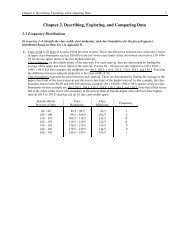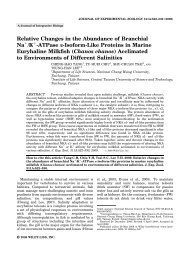Chapter 3. Probability
Chapter 3. Probability
Chapter 3. Probability
You also want an ePaper? Increase the reach of your titles
YUMPU automatically turns print PDFs into web optimized ePapers that Google loves.
70 <strong>Chapter</strong> 3: <strong>Probability</strong>In Exercises 9-13, use the following table, which summarizes blood groups and Rh types for100 typical people. These values may vary in different regions according to the ethnicity of thepopulation.Rh TypeO A B AB TotalPositive 39 35 8 4 86Negative 6 5 2 1 14Total 45 40 10 5 1009. Blood Groups and Types P(both of two randomly selected have O blood)a. with first selection replaced back into same data poolP(both O)= P(first O) ∗ P(second O from same pool)= 45/100 ∗ 45/100=0.450 ∗ 0.450= 0.203b. with first selection not replaced in the same data poolP(both O)= P(first O) ∗ P(second O from adjusted pool)= 45/100 ∗ 44/99=0.4500 ∗ 0.4444= 0.20010. Blood Groups and Types P(both of two randomly selected have Rh + blood)a. with first selection replaced back into same data poolP(both Rh + )= P(first Rh + ) ∗ P(second Rh + from same pool)= 86/100 ∗ 86/100=0.860 ∗ 0.860= 0.740b. with first selection not replaced in the same data poolP(both Rh + )= P(first Rh + ) ∗ P(second Rh + from adjusted pool)= 86/100 ∗ 85/99=0.8600 ∗ 0.8586= 0.73811. Blood Groups and Types P(three of three randomly selected have B blood)a. with first and second selections replaced back into same data poolP(all B)= P(first B) ∗ P(second B from same pool) ∗ P(third B from same pool)=10/100 ∗ 10/100 ∗ 10/100= 0.100 ∗ 0.100 ∗ 0.100= 0.00100b. with first and second selections not replaced in the same data poolP(all B)= P(first B) ∗ P(second B from adjusted pool) ∗ P(third B from adjusted pool)=10/100 ∗ 9/99 ∗ 8/98= 0.1000 ∗ 0.0909 ∗ 0.0816= 0.00074212. Blood Groups and Types P(four of four randomly selected have Rh – blood)a. with first, second, and third selections replaced back into same data poolP(all Rh – )= P(first Rh – ) ∗ P(second Rh – ) ∗ P(third Rh – ) ∗ P(fourth Rh – )=14/100 ∗ 14/100 ∗ 14/100 ∗ 14/100= 0.140 ∗ 0.140 ∗ 0.140 ∗ 0.140= 0.000384b. with first, second, and third selections not replaced in the same data poolP(all Rh – )= P(first Rh – ) ∗ P(second Rh – ) ∗ P(third Rh – ) ∗ P(fourth Rh – )=14/100 ∗ 13/99 ∗ 12/98 ∗ 11/97= 0.1400 ∗ 0.1313 ∗ 0.1224 ∗ 0.1134= 0.0002551<strong>3.</strong> Blood Groups and TypesP(10 randomly selected will have all have Type A blood)= 0.400 10 = 0.00010514. Wearing Hunting Orange6 out of 123 injured hunters were wearing hunting orange, 2 to be picked at randoma. P(two selected at random with replacement)= P(first) ∗ P(second)= 6/123 ∗ 6/123=0.0488 2 = 0.00238b. P(two selected at random without replacement)= P(first) ∗ P(second)= 6/123 ∗ 5/122=0.0488 ∗ 0.0410= 0.00200c. In this case, the population size is relatively small so the sampling without replacement would betterrepresent the actual probability of randomly selecting two injured hunters who were wearing hunter orangefrom a population of 123 injured hunters.




